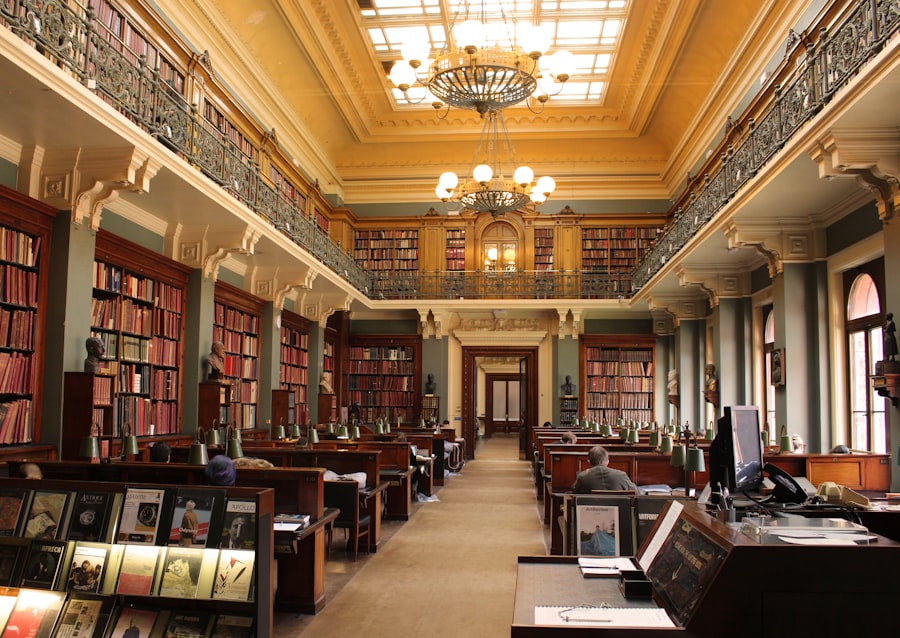
From Page to Screen: Books to Movies
Adapting books into movies is a complex and delicate process that requires careful consideration and skill. The goal is to bring the story and characters from the pages of a book to life on the big screen, while maintaining the essence of the source material. This process involves condensing a lengthy book into a two-hour movie, making creative decisions about what to include and what to leave out, and finding the right actors to portray the beloved characters. The art of adaptation is a balancing act between staying true to the original story and making changes that are necessary for the movie format.
Key Takeaways
- Adapting books into movies is an art that requires careful consideration and planning.
- Turning books into movies has its pros and cons, including the challenge of staying true to the source material while making it appealing to a wider audience.
- Book-to-movie adaptations have evolved over time, with advancements in technology and changes in audience preferences.
- Screenwriters play a crucial role in adapting books for the big screen, balancing the needs of the story with the demands of the medium.
- Casting the right actors is a challenge, but when successful, can elevate the movie and bring the characters to life.
The Pros and Cons of Turning Books into Movies
One of the major advantages of turning books into movies is that they often come with a built-in audience. Books that have already gained popularity and have a dedicated fan base can attract a large number of viewers to the movie adaptation. This built-in audience can help generate buzz and ensure a certain level of success at the box office.
However, condensing a book into a two-hour movie can be a major challenge. Books often contain intricate plots, complex characters, and rich world-building that can be difficult to translate onto the screen. Filmmakers must make tough decisions about what to include and what to cut, which can sometimes result in important elements of the story being left out or changed.
There have been both successful and unsuccessful adaptations throughout history. Some examples of successful adaptations include “The Lord of the Rings” trilogy, which brought J.R.R. Tolkien’s epic fantasy world to life in a visually stunning and faithful way, and “Gone Girl,” which captured the suspense and psychological depth of Gillian Flynn’s novel. On the other hand, there have been adaptations that failed to capture the essence of the source material, such as “The Golden Compass,” which received mixed reviews for its handling of Philip Pullman’s beloved fantasy series.
The Evolution of Book-to-Movie Adaptations
Book-to-movie adaptations have a long history, dating back to the early days of cinema. In the early 20th century, filmmakers began adapting classic novels and plays for the screen, often with great success. As technology advanced and audience expectations changed, so did the way books were adapted for the big screen.
In the early days of cinema, adaptations were often faithful to the source material, with filmmakers striving to recreate the story and characters as accurately as possible. However, as time went on, filmmakers began to take more creative liberties with adaptations, making changes to the story or characters in order to better suit the medium of film.
Changes in technology have also had a significant impact on book-to-movie adaptations. With advancements in visual effects, filmmakers are now able to bring fantastical worlds and creatures to life in ways that were once unimaginable. This has allowed for more faithful adaptations of books that contain elements that would be difficult or impossible to recreate using practical effects alone.
The Role of Screenwriters in Adapting Books for the Big Screen
| Metrics | Description |
|---|---|
| Box Office Revenue | The amount of money a movie adaptation of a book earns in theaters |
| Critical Reception | The reviews and ratings a movie adaptation of a book receives from film critics |
| Faithfulness to the Source Material | How closely a movie adaptation of a book follows the original story and characters |
| Screenplay Quality | The strength of the screenplay in terms of dialogue, pacing, and structure |
| Character Development | The depth and complexity of the characters in the movie adaptation of a book |
| Adaptation Difficulty | The level of complexity in adapting a particular book to the big screen |
Screenwriters play a crucial role in adapting books for the big screen. They are responsible for condensing a lengthy book into a two-hour movie, while still capturing the essence of the source material. This requires finding the right balance between staying true to the original story and making changes that are necessary for the movie format.
Successful screenwriters understand that not every scene or subplot from a book can be included in a movie adaptation. They must carefully choose which elements to prioritize and which ones can be left out or condensed. This often involves making tough decisions about what is essential to the story and what can be sacrificed.
Some examples of successful screenwriters who have excelled at adapting books for the big screen include Emma Donoghue, who adapted her own novel “Room” into an Oscar-winning screenplay, and Ted Tally, who won an Academy Award for his adaptation of Thomas Harris’ “The Silence of the Lambs.”
Casting the Right Actors: Challenges and Successes
Casting the right actors is crucial in bringing the characters from a book to life on the big screen. The actors must not only physically resemble the characters described in the book, but also embody their personalities and bring them to life in a believable way.
One of the challenges of casting popular book characters is that readers often have their own ideas about what the characters should look like and how they should behave. This can make it difficult for filmmakers to find actors who meet these expectations and satisfy the fans.
However, when the right actors are cast, it can result in a truly memorable adaptation. Some examples of successful casting choices include Daniel Radcliffe as Harry Potter in the “Harry Potter” series, Jennifer Lawrence as Katniss Everdeen in “The Hunger Games,” and Viggo Mortensen as Aragorn in “The Lord of the Rings” trilogy. These actors not only physically resembled the characters from the books, but also brought depth and nuance to their performances.
The Importance of Staying True to the Source Material

Staying true to the source material is crucial in creating a successful book-to-movie adaptation. Changes to the story or characters can have a significant impact on the audience’s perception of the adaptation, and can sometimes alienate fans of the original book.
When changes are made, they must be done with care and consideration for how they will affect the overall story and themes. Filmmakers must understand what made the book beloved in the first place and strive to capture that essence on screen.
Some examples of adaptations that stayed true to the source material include “To Kill a Mockingbird,” which faithfully captured Harper Lee’s powerful exploration of racism and injustice, and “The Shawshank Redemption,” which maintained the emotional depth and redemption themes of Stephen King’s novella.
The Impact of Visual Effects on Book-to-Movie Adaptations
Visual effects play a crucial role in bringing the world of a book to life on the big screen. They allow filmmakers to create fantastical creatures, epic landscapes, and magical worlds that would be impossible to recreate using practical effects alone.
When used effectively, visual effects can enhance the storytelling and immerse the audience in the world of the book. However, when used poorly or excessively, they can detract from the story and feel artificial.
Some examples of successful use of visual effects in book-to-movie adaptations include “The Lord of the Rings” trilogy, which brought Middle-earth to life in a visually stunning and immersive way, and “Harry Potter and the Prisoner of Azkaban,” which used visual effects to create the magical creatures and environments of J.K. Rowling’s wizarding world.
On the other hand, there have been adaptations that relied too heavily on visual effects at the expense of storytelling, such as “The Hobbit” trilogy, which received criticism for its excessive use of CG
The Role of Music in Enhancing the Movie Experience
Music plays a crucial role in enhancing the movie experience and setting the tone for a book-to-movie adaptation. It can heighten emotional moments, create tension, and transport the audience into the world of the story.
A well-chosen soundtrack can become synonymous with a book-to-movie adaptation and evoke strong emotions in viewers. Some examples of successful movie soundtracks include “The Lord of the Rings” trilogy, which featured epic and sweeping orchestral music by Howard Shore, and “The Hunger Games,” which included powerful and haunting songs by artists such as Taylor Swift and Lorde.
Music can also help establish a sense of time and place in a book-to-movie adaptation. For example, the soundtrack for “The Great Gatsby” featured a mix of contemporary and period music, which helped transport viewers to the 1920s setting of F. Scott Fitzgerald’s novel.
The Influence of Book-to-Movie Adaptations on Pop Culture
Book-to-movie adaptations have had a significant impact on society and pop culture. They have the power to introduce new audiences to beloved books and authors, spark discussions about the adaptation process, and inspire fan communities.
Some adaptations have become cultural phenomena in their own right, with fans eagerly anticipating each new installment in a series or dressing up as their favorite characters for conventions and premieres. These adaptations have the power to bring people together and create a sense of community among fans.
Some examples of book-to-movie adaptations that had a significant impact on pop culture include the “Harry Potter” series, which introduced a whole new generation to J.K. Rowling’s magical world, and “The Hunger Games,” which sparked discussions about social inequality and government control.
The Future of Book-to-Movie Adaptations
The future of book-to-movie adaptations is bright, with many potential successful adaptations on the horizon. As technology continues to advance, filmmakers will have even more tools at their disposal to bring the worlds of books to life on the big screen.
However, it is important for filmmakers to remember the importance of maintaining the essence of the source material while making changes for the movie format. Fans of the original books have a deep connection to the stories and characters, and it is crucial to respect that connection when adapting them for film.
In conclusion, adapting books into movies is an art form that requires careful consideration and skill. It involves condensing a lengthy book into a two-hour movie, making creative decisions about what to include and what to leave out, and finding the right actors to portray the beloved characters. While there are challenges in adapting books for the big screen, there have been many successful adaptations throughout history that have captured the essence of the source material and resonated with audiences. With the right balance of staying true to the source material and making changes for the movie format, book-to-movie adaptations have the potential to continue to captivate audiences and leave a lasting impact on pop culture.
FAQs
What are some popular books that have been turned into movies?
Some popular books that have been turned into movies include “The Lord of the Rings,” “Harry Potter,” “The Hunger Games,” “The Fault in Our Stars,” “The Da Vinci Code,” and “The Girl on the Train.”
Why do books get turned into movies?
Books get turned into movies because they have a built-in audience and a pre-existing story that can be adapted for the screen. Additionally, movies based on books often have a higher chance of success because the story has already proven to be popular with readers.
Are movies always faithful to the books they are based on?
No, movies are not always faithful to the books they are based on. Sometimes changes are made to the story or characters to make the movie more visually appealing or to fit within a certain time frame. However, some movies do stay very close to the original book.
Do authors have any say in how their books are adapted into movies?
Authors may have some say in how their books are adapted into movies, but ultimately it is up to the filmmakers to make creative decisions. Some authors may have more involvement in the process if they are also serving as a producer or screenwriter for the movie.
Do movies based on books always do well at the box office?
No, movies based on books do not always do well at the box office. While some movies have been very successful, others have not performed as well as expected. The success of a movie based on a book depends on many factors, including the popularity of the book, the quality of the adaptation, and the marketing campaign.













